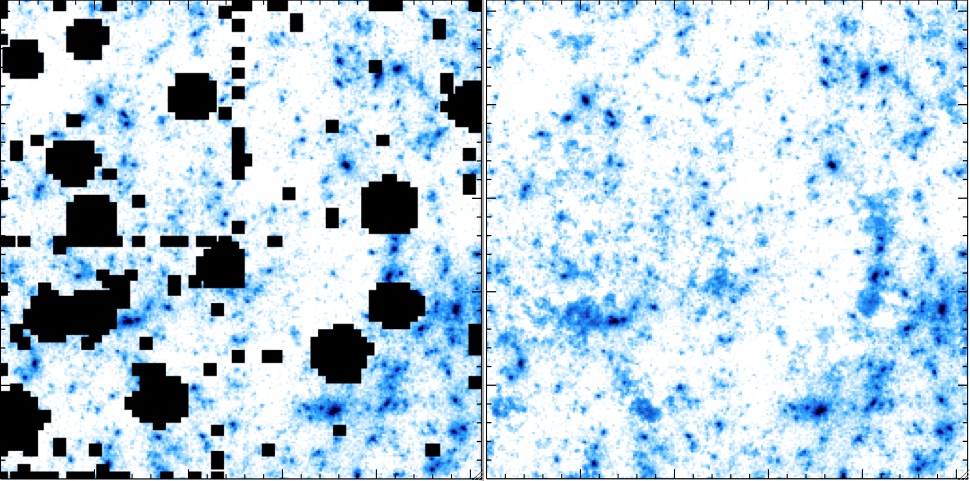Weak gravitational lensing is believed to be the most promising tool to map the dark matter and to constrain the cosmological model used to describe the Universe. Future weak lensing surveys are already planned in order to cover a large fraction of the sky with large accuracy. However this increased accuracy also places greater demands on the methods used to extract the available information, in particular in the reconstruction of the dark matter distribution from shear estimation.
The 2D mass inversion problem
The analysis of weak lensing data requires to account for missing data such as masking out of bright stars. The solution that is proposed by FASTLens is to properly fill-in the gaps with only NlogN operations, leading to a complete weak lensing mass map from which we can compute straight forwardly and with a very good accuracy any kind of statistics like power spectrum or bispectrum. The inpainting method relies strongly on the notion of sparsity and on the construction of sparse representations in large redundant dictionaries (Pires, Starck, Réfrégier et al. 2009)

We have also shown that there is a clear relation between the Helmholtz decomposition of a vector field and the E and B modes reconstruction from weak lensing data, and we have derived a new Wavelet Helmholtz decomposition to reconstruct the dark matter mass map. Using this idea, we can design very specific curl-free and divergence-free wavelets, which allows to better recover the information on the border of the field (Deriaz, Starck, Pires A&A,, 2012).
The 2D mass denoising
Several methods are used to derive the lensing shear from the shapes of background galaxies. But the shear map obtained is always noisy, and when it is converted into a map of the projected mass map, the result is dominated by the noise.
MRLens offers a new algorithm for the reconstruction of Weak Lensing mass maps (Starck, Pires et al., 2006).

Applications on real data
The MRLens code has been applied to the COSMOS and it has enabled to show a good spatial correlation between visible and dark matter (Massey et al, Nature, 2007).
The Flens codes (that includes MRLens and FASTLens) have been applied to the MACS J0717+3745 galaxy cluster field (Jullo, Pires et al. 2014), and reveal the filamentary structure discovered in Jauzac et al. (2012).

The Codes
The following software packages are publicly available:
- Software FASTLens : FASTLens (Fast STatistics for weak Lensing) is a package written in C++ that includes: an inpainting code to derive complete weak lensing mass maps from incomplete shear maps, a power spectrum estimator, a bispectrum estimator (for equilateral and isoscele configurations). We propose also a new method to compute fastly and accurately the power spectrum and the bispectrum with a polar FFT algorithm.
- Software MRLens : MRLens (Multi-Resolution tools for gravitational Lensing) is a software written in C++ with an IDL interface. This method uses the Multiscale Entropy concept (which is based on wavelets) and the False Discovery Rate (FDR) which allows us to derive robust detection levels in wavelet space. MRLens has been used to process the COSMOS map (see Figure above)..
Publications
- “Weak Lensig Mass Reconstruction using Wavelets“, J.-L. Starck, S. Pires, and A. Refregier, A&A, 451, 3, 1139-1150, 2006
- “Sunyaev-Zel’dovich clusters reconstruction in multiband bolometer camera surveyl“, S. Pires, J.B. Juin, D. Yvon, Y. Moudden, S. Anthoine, and E. Pierpaoli, A&A, 455, 2, 741-755, 2006
- “Dark matter maps reveal cosmic scaffolding“, R. Massey, J. Rhodes, R. Ellis, N. Scoville, A. Leathaud, A. Finoguenov, P. Capak, D. Bacon, H. Aussel, J.-P. Kneib, A. Koekemoer, H. McCracken, B. Mobasher, S. Pires, A. Réfrégier, S. Sasaki, ,J.-L. Starck, Y. Taniguchi and J. Taylor, Nature, 445, 7125, 286-290, 2007
- “Full-sky Weak Lensing Simulation with 70 Billions Particles“, R. Teyssier, S. Pires, D. Aubert, C. Pichon, S. Prunet, A. Amara, K. Benabed, S. Colombi, A. Réfrégier and J.-L.Starck, A&A, 497, 2, 335-341, 2009
- “FASTLENS (FAst STatistics for weak Lensing): Fast method for Weak Lensing Statistics and map making“, S. Pires, J.-L. Starck, A. Amara, R. Teyssier, A. Réfrégier and J. Fadili, MNRAS, 395, 3, 1265-1279, 2009.
- “Wavelet Helmholtz decomposition for weak lensing mass map reconstruction“, E. Deriaz, S. Pires, J.-L. Starck, A&A, 540, A34, 2012
- “Weak lensing Galaxy Cluster Field Reconstruction”, E. Jullo, S. Pires, M. Jauzac, J.-P. Kneib, MNRAS, 437, 4, 3969-3979, February 2014
